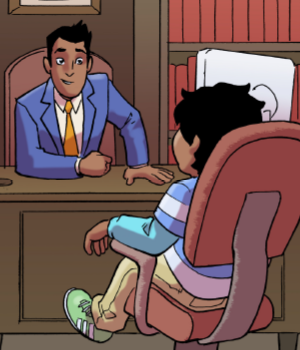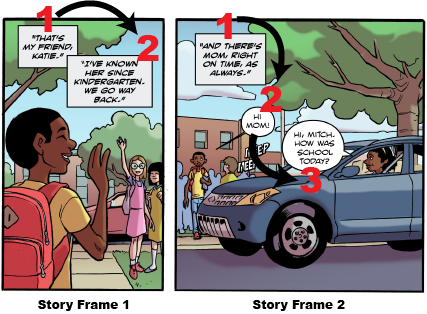Menu
Family and Dependency Court
Criminal Court
Human Trafficking
Children and Youth in Tribal Communities
A Guide for Practitioners
These materials were created specifically for children and youth in Tribal communities by Native authors and illustrators and are tailored to the needs of young children (ages 2 to 6), school-age children (ages 7 to 12), and teens (ages 13 to 18) who have been the victim and/or witness to a crime and are interacting with Tribal, state, and/or federal justice systems as a result. For each age group, there are separate books about the criminal legal system and the child welfare system, so you can choose the pieces that will be most helpful to the child and family you are working with.
Given the rich diversity among Native communities, the materials were designed to be dynamic and adaptable to each reader’s local context. They are intended to be relatable to the broadest possible audience; however, not every element will feel relevant to every child, caregiver, or community. As a practitioner, we encourage you to adapt the materials as necessary by changing features of the story that relate to jurisdiction, Tribal justice system processes, the community context, and cultural references so that they are as supportive, validating, and educational as possible.
How to Read the Materials
The materials for school-age children (ages 7–12) and youth (ages 13–18) are formatted in a graphic novel style. Because not everyone is familiar with graphic novels, it may be helpful to explain the format to each young person before you begin reading.
Graphic novels are broken up into separate story frames or panels. A story frame is an individual drawing on a single section of the page, and each frame is separated by boxes. These frames are read in order from left-to-right like a traditional storybook and then top-to-bottom. The speech bubbles within each frame are most often read from left-to-right and then top-to-bottom, when applicable. See the graphic below for an example of two story frames from Marvelous Mitch.
Some of the novels use different color schemes and time markers to indicate flashback scenes, where the story transitions from the present day to an event that occurred in the past.
How to Use the Materials
Here are some suggestions for how to use the materials most effectively:
- Familiarize yourself with the materials first, before providing them to children or caregivers.
- Provide the materials to the child and their caregiver(s) as early in the justice system process as possible, and regardless of what the case outcome might be.
- If a child doesn’t yet read well, either you or one of the other people working on their case, such as a therapist or advocate, can read the materials to them.
- Regardless of a child’s age, it is important that an adult, ideally one with a prior trusting relationship with the youth, is available to help them understand what they are reading and provide emotional support.
- Whenever possible, ensure that caregivers are provided with the materials first, so they are aware of the content and can be the primary support for their youth during this process. It benefits children when their caregivers also learn about coping skills and how the justice system works.
- The materials can be read all the way through in one sitting, or different sections can be used at different times, depending on a child’s situation, their age, the stage of their case, and how they are feeling. For example, you may choose to use the sections about testifying only if it is likely a child will testify or use the section on foster care only if a child has had that experience.
- As you read the story, you’ll come across activities along the way. Encourage children to try the activities, because they teach coping skills that can help them (and maybe you!) de-stress. You can also use the activities as reminders to take a break and check in with the child about how they’re feeling.
- Be aware that children can be triggered by anything that reminds them of the traumas they have experienced. If a child becomes distressed, it is okay to take a break, offer support, and practice coping skills like deep breathing together.
- Feel free to make changes to the materials so that they work well for each child. This might mean adjusting the details of what happens in the story or using words that make more sense in your community.
- Ask children questions to help connect the story to their feelings and experiences. Some examples: Is there someone like Gabi helping you? Brandon was angry when this happened; how do you think you would feel?
- We recognize that all courtrooms look different. You may want to explain how your courtroom looks different from the diagram in the materials and/or compare a photo of your courtroom with the diagram.
- Consider keeping the materials in your office if there is someone living in a child’s home who should not have access to them, such as the defendant.
Tips for Supporting Young Child Victims and Witnesses
Here are some ways to support children while using these materials, and as they go through this experience:
- Let them know that it is okay to have a lot of big feelings, or no feelings at all, and that there are things they can do to feel better.
- Remind them that none of this is their fault.
- Meet with them in a child-friendly space, if possible. Sitting on the rug with them or providing Play-Doh and materials for coloring can go a long way in helping children feel more comfortable.
- Tell them that they are not the only one who has gone through this; other kids and families have had these experiences, too.
- Remember to use language that children can understand, especially when explaining the justice system. Ask children (and adults) to repeat back the information in their own words, so you can assess if they understood fully.
- Keep in mind that you may have to provide the same information multiple times and/or in multiple ways (e.g., verbally and in writing).
- As much as you can, let children (and adults) know what to expect each step of the way, so they can feel less anxious and more prepared.
- Remind them that there are people who support them, such as family members, friends, elders, Tribal leaders, caseworkers, advocates, therapists, and lawyers, and name those people together.
- Make sure that children and caregivers are aware of any resources they need now or may need in the future, including victim advocacy services and trauma-focused therapy.
- Encourage children to ask as many questions as they’d like, and to express their thoughts and feelings to you, their caregivers, and other grownups working on their case.
- Give children the chance to make choices whenever possible, even about seemingly minor things such as where each person sits, when to take a break, which topic to discuss first, or which parts of the materials to work on each time you meet. This helps children regain their sense of control and personal power.
- Support children and families in connecting with their culture and community as a source of strength and healing.
- Remind children that they are strong and will get through this.



